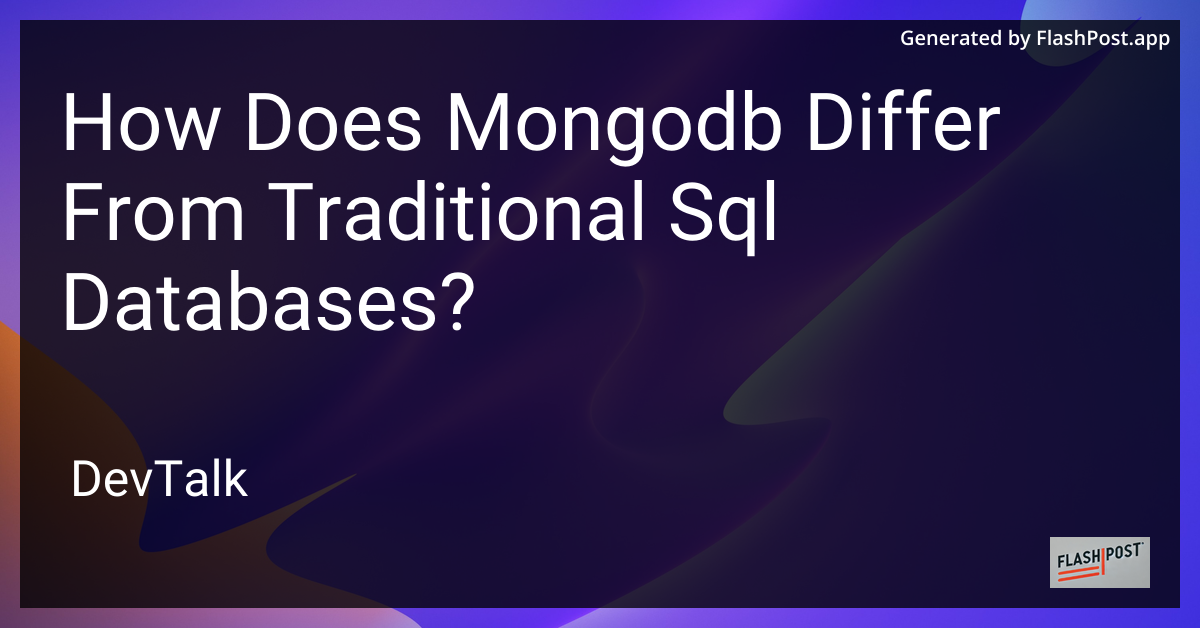How Does Mongodb Differ From Traditional Sql Databases?
 # How Does MongoDB Differ from Traditional SQL Databases?
# How Does MongoDB Differ from Traditional SQL Databases?
In the world of databases, choosing the right one to fit your project’s needs can significantly impact performance, scalability, and flexibility.
MongoDB and traditional SQL databases are two popular options, each having its unique features and use cases. In this article, we will explore how MongoDB differs from traditional SQL databases, focusing on data models, schema design, query language, scalability, and use cases.
Data Models
MongoDB's Document-Oriented Model
At its core, MongoDB is a NoSQL database that uses a document-oriented data model. Instead of storing data in rows and columns like SQL databases, MongoDB stores data in flexible, JSON-like documents. Each document, a BSON (Binary JSON) format, can contain nested arrays and sub-documents, making it highly flexible and capable of representing complex hierarchical relationships.
SQL's Relational Model
Traditional SQL databases, such as MySQL or PostgreSQL, use a structured, table-based relational model. Data is organized into tables with predefined schemas consisting of rows and columns. Relationships between tables are established using foreign keys, ensuring data consistency and integrity through ACID transactions.
Schema Design
Flexible Schema in MongoDB
MongoDB offers a dynamic schema, allowing documents in the same collection to have different fields. This flexibility supports rapid iteration and evolution of your application’s data model without the need for costly schema migration.
Rigid Schema in SQL
Conversely, SQL databases enforce a strict schema. Changing the structure of a database often involves altering tables, which can be complex and time-consuming, especially for large datasets. However, the predefined schema ensures consistent data organization and integrity.
Query Language
MongoDB Query Language (MQL)
MongoDB uses its own query language known as MQL. It is designed to accommodate the database’s document-oriented model, offering powerful features like document update methods and aggregation operations. MongoDB also supports indexing and various search options to optimize query performance.
SQL Query Language
SQL databases utilize the Structured Query Language (SQL), a mature and standardized query language that provides complex querying and data manipulation capabilities. SQL is known for its expressiveness and ability to handle intricate queries, making it suitable for applications with complex transactional needs.
Scalability
Horizontal Scalability with MongoDB
MongoDB excels in horizontal scalability, allowing for easy distribution of data across multiple nodes using sharding. This makes MongoDB ideal for applications that require high availability and handle massive amounts of data, which is crucial in today's data-driven world.
Vertical Scalability with SQL
Traditional SQL databases typically scale vertically, meaning they require more powerful hardware as the data volume grows. While some SQL databases offer horizontal scalability features, it generally involves significant complexity and potential re-architecture of the database setup.
Use Cases
Ideal Use Cases for MongoDB
MongoDB’s flexible schema and horizontal scalability make it suitable for a range of applications, including:
- Content management systems
- Real-time analytics
- Mobile and web applications
- Internet of Things (IoT) systems
- Aggregation framework for complex queries
Ideal Use Cases for SQL Databases
SQL databases are a strong fit for scenarios requiring:
- Complex transactions and data integrity
- Banking and financial applications
- Historical data analysis
- Enterprise resource planning (ERP) systems
Conclusion
The choice between MongoDB and traditional SQL databases depends on your specific application requirements. MongoDB provides flexibility, scalability, and performance improvements for modern applications, especially when you need to handle diverse data structures. SQL databases, with their robust transaction support, are invaluable for complex operations requiring consistent and reliable data management.
MongoDB is an excellent choice for modern, agile development environments where rapid iteration is key. In contrast, SQL databases are indispensable for applications requiring structured data and strict consistency.
For more insights into MongoDB features and operations, check out how to add a new column key in MongoDB at runtime.
By understanding the distinctions between these two types of databases, you can make informed decisions that align with your project’s objectives and technical needs.